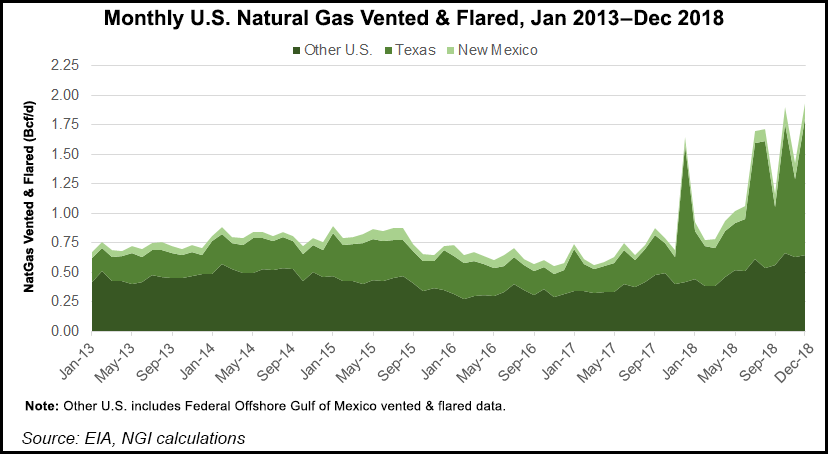Shale Daily | E&P | NGI All News Access | NGI The Weekly Gas Market Report
ExxonMobil, Pioneer Natural Collaborate on Project Astra to Reduce Permian Methane Emissions
A first-of-its-kind sensor network to monitor methane emissions across the Permian Basin in West Texas, dubbed Project Astra, may revolutionize the way leaks are found and repaired.

ExxonMobil, Pioneer Natural Resources Co., the Gas Technology Institute (GTI), The University of Texas at Austin (UT) and the Environmental Defense Fund (EDF) are collaborating in the endeavor, which is expected to have initial results by year’s end.
“Project Astra is an ambitious and innovative collaboration to develop comprehensive, continuous monitoring of methane emissions, a potential new capability that can be achieved with industry-wide participation,” said ExxonMobil’s Staale Gjervik, senior vice president of unconventional. “ExxonMobil is committed to the development of technologies and partnerships that advance cost-effective solutions to reduce methane emissions.”
Potentially, the sensor network could allow producers and regulators to find and fix significant methane releases at or below the cost of current monitoring technologies, many of which measure emissions only on an annual or semi-annual basis.
Methane emissions across the Permian, both in West Texas and southeastern New Mexico, have been the bane of exploration and production companies for years. Last month, ExxonMobil said it had begun field trials at nearly 1,000 Texas and New Mexico sites for eight emerging methane detection technologies.
The first phase of development, to test a wide range of methane sensing technologies and assess their ability to operate autonomously, is to be conducted in West Texas. The full network would be designed in virtual reality, using a simulation of oil and gas production across the West Texas region.
The simulation, created at UT, would model minute-by-minute concentrations of methane and other components of natural gas that would be expected in the atmosphere under normal operations and when unintended emissions are present. The simulated atmosphere, to be completed by the end of this year, would be used to identify the types and locations of methane sensors most effective in collecting data. It would also be used to evaluate methods to analyze the sensor data to locate unintended emissions.
“This project has incredible potential and will open new pathways for companies to find and reduce methane emissions from the more than one million existing oil and gas wells in the United States,” said UT’s David Allen, lead investigator and director of the Cockrell School of Engineering’s Center for Energy and Environmental Resources.
“Cost-effective, high-frequency monitoring for these assets will require innovative and disruptive techniques. The goal of Project Astra is to design, develop and deploy a prototype, next-generation monitoring network.”
[Check out NGI’s 2020 Map of North American Natural Gas Pipelines, LNG Facilities & Shale Plays]
The project team’s simulated data set would be used as the basis for a “Digital Methane Challenge,” an initiative funded by UT’s Energy Institute that catalyzes innovation in network designs. When a successful design is demonstrated in the simulated atmosphere, the network sensing concept would be tested in the Permian.
Technical and policy expertise for developing advanced methane solutions that can improve environmental performance is provided by EDF, long a collaborator with the Lower 48 oil and gas industry to reduce emissions. Industry participants in the study also are providing university researchers access to production facilities and operational data.
“Pioneer cares deeply about our environmental impact, and we have a long-term focus on reducing emissions in our operations,” said Executive Vice President Mark Berg, who oversees corporate operations. Project Astra “offers significant opportunities to advance technology in detecting and reducing methane emissions and help our industry address this critical issue.”
The findings and analyses of the project, to be published in peer-reviewed journals and made publicly available, could help guide how companies, states and the federal government measure, monitor and manage methane emissions in the future.
“Reducing methane emissions is a serious issue, requiring much faster and more aggressive industry action,” said EDF’s Matt Watson, Energy vice president. “Continuous detection could be a game changer for the entire industry to eradicate methane emissions — and for policymakers to have the data needed to verify those reductions.”
GTI’s Paula Gant, senior vice president of corporate strategy and innovation, also weighed in.
“Success in Project Astra will help accelerate deployment of innovative solutions to find and fix leaking equipment faster and more effectively at local-area scale,” said Gant. “We envision creating interconnected networks of sensors monitoring emissions over large areas that feed data into decision tools that can speed repair actions.”
Also studying methane emissions in the Lone Star State is the Texas Methane and Flaring Coalition, launched in April. Among other things, the coalition wants to define why and when flaring is necessary and communicate the environmental and safety reasons that may necessitate flaring. It also wants to identify, assess and recommend opportunities and best practices, as well as evaluate existing studies.
© 2024 Natural Gas Intelligence. All rights reserved.
ISSN © 2577-9877 | ISSN © 1532-1266 | ISSN © 2158-8023 |
